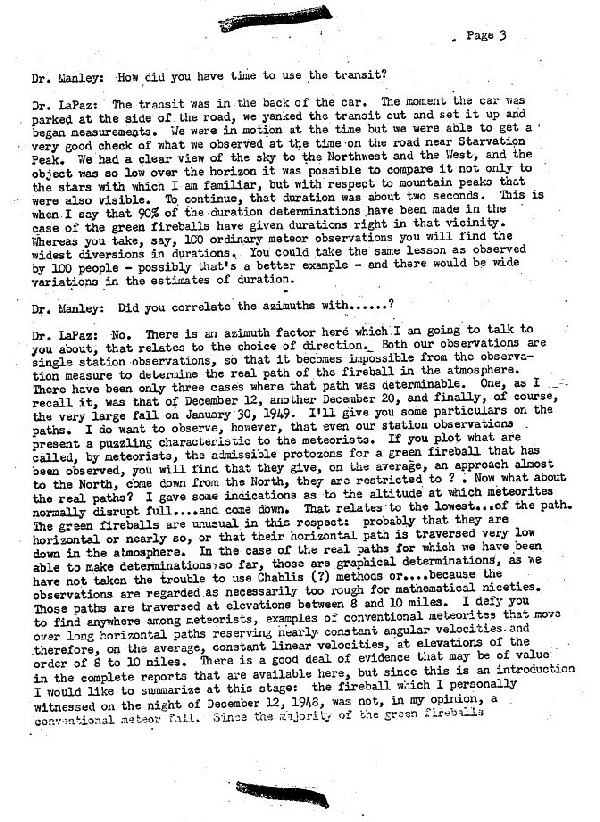This is one of the 24 pages of one of the many formerly secret official documents on this issue. These pages are the minutes of an important conference on the issue held at Los Alamos on February 16, 1949. Representatives of the Army, the FBI, the Air Force and scientists joined together. Dr. La Paz spent two years chasing the green fireballs and explains the issues. Dr. Edward Teller, one of the fathers of the atomic bomb, asks questions.
1 2 3 4 5 6 7 8 9 10 11 12 13 14 15 16 17 18 19 20 21 22 23 24

|
Dr. Manley: How did you have time to use the transit?
Dr. La Paz: The transit was at the back of the car. The moment the car was parked at the side of the road, we yanked the transit cut and set it up and began measurements. We were in motion at the time but we were able to get a very good check of what we observed at the time on the road near Starvation Peak. We had a clear view of the sky to the Northwest and the West, and the object was so low over the horizon it was possible to compare it not only to the stars with which I am familiar, but with respect to mountain peaks which were also visible. To continue, that duration was almost two seconds. This is when I say that 90% of the duration determinations have been made in the case of the green fireballs have given durations right in that vicinity. Whereas you take, say, 100 ordinary meteor observations you will find the widest diversions in durations. You could take the same lessons as observed by 100 people - possibly that's a better example - and there would be wide variations in the estimates of duration.
Dr. Manley: did you correlate the azimuths with...?
Dr. LaPaz: No. There is an azimuth factor here which I am going to talk to you about, that relates to the choice of direction. Both our observations are single station observations, so that it becomes impossible for the observation measures to determine the real path of the fireball in the atmosphere. There have been only three cases where that path was determinable. One, as I recall it, was that of December 12, another December 20, and finally, of course, the very large fall on January 30, 1949. I'll give you some particulars on the paths. I do want to observe, however, that even our station observations present a puzzling characteristic of the meteorite. If you plot what are called, by meteorists, the admissible protozons for a green fireball that has been observed, you will find that they give, on the average, an approach almost to the North, come down from the North, they are restricted to? Now what about the real paths? I gave some indications as to the altitudes at which meteorites normally disrupt full... and come down. That relates to the lowest ... of the path. The green fireballs are unusual in this respect: probably they are horizontal or nearly so, or that their horizontal path is traversed very low down in the atmosphere. In the case of the real paths for which we have been able to make determinations so far, those are graphical determinations, as we have not taken the trouble to use Chablis (?) methods or... because the observations are regarded as necessarily too rough for mathematical niceties. Those paths are traversed at elevations between 8 and 10 miles. I defy you to find anywhere among meteorists, examples of conventional meteorites that move over long horizontal paths reserving nearly constant angular velocities and therefore, on the average, constant linear velocities, at elevations of the order of 8 to 10 miles. There is a good deal of evidence that may be of value in the complete reports that are available here, but since this is an introduction I would like to summarize at this stage: the fireball which I personally witnessed on the night of December 12, 1948, was not, in my opinion, a conventional meteor fall. Since the majority of the green fireballs
1 2 3 4 5 6 7 8 9 10 11 12 13 14 15 16 17 18 19 20 21 22 23 24